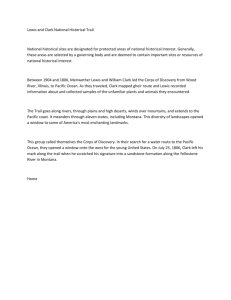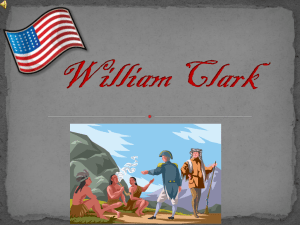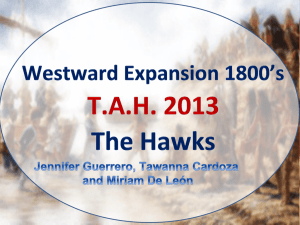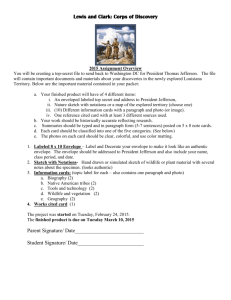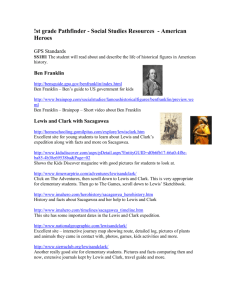ISTE Lesson Plan
advertisement
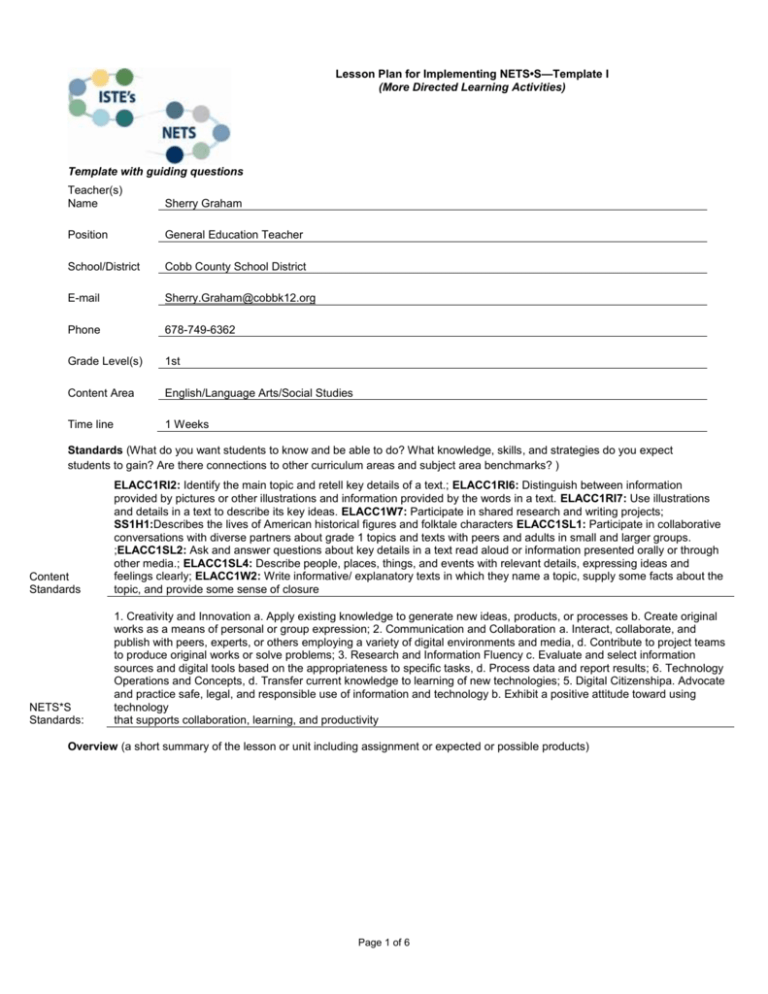
Lesson Plan for Implementing NETS•S—Template I (More Directed Learning Activities) Template with guiding questions Teacher(s) Name Sherry Graham Position General Education Teacher School/District Cobb County School District E-mail Sherry.Graham@cobbk12.org Phone 678-749-6362 Grade Level(s) 1st Content Area English/Language Arts/Social Studies Time line 1 Weeks Standards (What do you want students to know and be able to do? What knowledge, skills, and strategies do you expect students to gain? Are there connections to other curriculum areas and subject area benchmarks? ) Content Standards ELACC1RI2: Identify the main topic and retell key details of a text.; ELACC1RI6: Distinguish between information provided by pictures or other illustrations and information provided by the words in a text. ELACC1RI7: Use illustrations and details in a text to describe its key ideas. ELACC1W7: Participate in shared research and writing projects; SS1H1:Describes the lives of American historical figures and folktale characters ELACC1SL1: Participate in collaborative conversations with diverse partners about grade 1 topics and texts with peers and adults in small and larger groups. ;ELACC1SL2: Ask and answer questions about key details in a text read aloud or information presented orally or through other media.; ELACC1SL4: Describe people, places, things, and events with relevant details, expressing ideas and feelings clearly; ELACC1W2: Write informative/ explanatory texts in which they name a topic, supply some facts about the topic, and provide some sense of closure NETS*S Standards: 1. Creativity and Innovation a. Apply existing knowledge to generate new ideas, products, or processes b. Create original works as a means of personal or group expression; 2. Communication and Collaboration a. Interact, collaborate, and publish with peers, experts, or others employing a variety of digital environments and media, d. Contribute to project teams to produce original works or solve problems; 3. Research and Information Fluency c. Evaluate and select information sources and digital tools based on the appropriateness to specific tasks, d. Process data and report results; 6. Technology Operations and Concepts, d. Transfer current knowledge to learning of new technologies; 5. Digital Citizenshipa. Advocate and practice safe, legal, and responsible use of information and technology b. Exhibit a positive attitude toward using technology that supports collaboration, learning, and productivity Overview (a short summary of the lesson or unit including assignment or expected or possible products) Page 1 of 6 This unit focuses on social studies, reading, writing, and technology standards. Students will bring minimal prior knowledge about the explorers Lewis and Clark as well as Sacagawea to the unit. The teacher will expose students to multiple informational texts about Lewis and Clark as well as Sacagawea. To activate knowledge, the teacher will show a www.BrainPopJr.com learning focused video on Lewis and Clark to the class. Students will reflect on their knowledge. Throughout the unit, students will learn to infer, generate questions on informational text, cite evidence to prove and justify their reasons about characters and events in Reading. In Social Studies, they will specifically look at the American Historical figures to give them the tools to describe their lives. In Writing, students will participate in shared research projects by utilizing www.pebblego.com and reporting on their knowledge by producing informational test. The students will complete a graphic organizer after they've gained concrete knowledge on Lewis and Clark. They will transfer the new learning that focuses on the main topic and key details of informational text to into a bubbl.us concept map, located at www.bubbl.us. They will be expected to print these for assessment. Finally, students will be expected to demonstrate their knowledge through an activity that utilizes www.voicethread.com. Within Voicethread, students will have pictures available of various images of Lewis and Clark as well as Sacagawea. They will be working in groups of 2-3 to comment on an image of choice of Lewis and Clark/ Sacageawea to answer questions about key details in a text. The question they will be expected to answer will depend on their ability level and need, which will be assigned as a written prompt. Students will be exposed to the prompts in small groups. Students will choose which prompt they want to respond to and the teacher will create pairs that choose the same prompts. The pairs will be expected to participate in collaborative conversations with diverse partners with in the classroom setting to discuss contributions of Lewis and Clark using Voicethread. Essential Questions (What essential question or learning are you addressing? What would students care or want to know about the topic? What are some questions to get students thinking about the topic or generate interest about the topic? What questions can you ask students to help them focus on important aspects of the topic? What background or prior knowledge will you expect students to bring to this topic and build on?) Page 2 of 6 Examples of essential questions for learning activities include: EQ: How can I identify the main topic and retell key details of a text? EQ: How can I distinguish between information provided by pictures or other illustrations and information provided by the words in a text? EQ: How do illustrations and details in a text to describe its key ideas? EQ: In what ways can I participate in shared research and writing project about Lewis and Clark? EQ: How can I describe the lives of American historical figures Meriwether Lewis, William Clark, and Sacagawea? EQ: How can I effectively participate in collaborative conversations with diverse partners in small and larger groups? EQ: In what ways can I ask and answer questions about key details in a text? EQ: How can I describe people, places, things, and events with relevant details, expressing ideas and feelings clearly? EQ: How can I write informative/ explanatory texts about Lewis and Clark and Sacagawea where I name a topic, supply some facts about the topic, and provide some sense of closure? EQ: How do I use technology to help me learn? EQ: How do I use technology to show what I know about a topic? Specific questions/answer prompts to review with students as they are learning: Create 3 questions that you would ask Lewis and Clark if you met them today. Describe the contributions that Lewis&Clark and Sacagawea have had on our country. Analyze an image of your choice of Lewis&Clark. Cite evidence of the key details that you observe within the picture. How can you compare and contrast character traits of Lewis and Clark to Thomas Jefferson? Why was their journey was called the “Voyage of Discovery”? Meriwether Lewis collected plants, rocks, and other items to study and share with others. Make your own specimen box and describe its contents. An expedition is a journey with a specific goal. What is an expedition you’d like to go on? Where would you go? Why? How would you get there? Formulate a specific problem that Lewis and Clark or Sacagawea were likely to have faced as they explored the west. Imagine you were Lewis or Clark and you encountered American Indians. Develop an approach you would have taken to interact with them effectively. An expedition is a journey with a specific goal. What is an expedition you’d like to go on? Where would you go? Why? How would you get there? Analyze the adventures of Lewis& Clark and Sacagawea by citing facts and providing opinions of the historical figures. Analyze the author’s purpose in creating the text, “Lewis and Clark: A Prariedog for the President” about Lewis and Clark’s explorations. Select or devise an approach that you would have taken if you were Lewis and Clark and were asked to explore the last west as you sought out to reach the Pacific Ocean. What challenges did Lewis and Clark face on their journey? What was the purpose of their journey? How did Sacagawea provide Lewis and Clark with assistance? What challenges would they have faced if they did not encounter her? Students should have prior knowledge about Thomas Jefferson and his character traits/contributions because it is his actions that cause the explorers to begin their expedition. They should also have a general understanding about what the country looks like and how it was developed. This includes knowledge of the 13 colonies, England, as well as the physical makeup/map of the United States. Page 3 of 6 Assessment (What will students do or produce to illustrate their learning? What can students do to generate new knowledge? How will you assess how students are progressing (formative assessment)? How will you assess what they produce or do? How will you differentiate products?) Students will be assessed using both informal and formal assessments. Students will create a www.bubbl.us concept map as well as a differentiated handwritten graphic organizer to assess their knowledge of the main topic and key details in an informational text. They will be able to generate new knowledge as they research using www.Pebblego.com and www.brainpopjr.com to research Lewis and Clark. They will apply their knowledge utilizing www.voicethread.com . Students will work in pairs to respond to prompts using this Web2.0 technology. Here, their ability to work in groups to meet Speaking and Listening standards will be addressed. This form of assessment will be recorded during a writing assessment during an “All About Lewis and Clark” writing unit that utilizes the research performed during the unit and assesses multiple standards. Rubrics are attached to the written assessments. Checklists are included to address ability to work in collaborative groups. Links to assessments used in the unit, as well as corresponding rubrics are located here. The order is as follows: • Pages 1-3: Overview/Unit Summary • Pages 4-5 Differentiated research activity to correspond with www.PebbleGo.com task. • Page 6- Rubric for www.PebbleGo.com and www.BrainPopJr.com assignment • Pages 7-8: Differentiated Graphic organizers to be used with the www.bubbl.us concept map. • Page 9- Rubric for www.bubbl.us assignment. • Pages 10-14: Questions/Prompts for students to analyze, collaborate on, and address using www.voicethread.com. • Page 15- Rubric for www.voicethread.com assignment. • Page 16- Informational Writing checklist for student use and teacher review • Page 17-18 All About Lewis and Clark/Sacagawea research project that integrates writing. • Page 19- Classroom Conversations Checklist to address whether or not a child is meeting the speaking and listening standards assessed. • Page 20—Rubric for culminating Informational writing project Resources (How does technology support student learning? What digital tools, and resources—online student tools, research sites, student handouts, tools, tutorials, templates, assessment rubrics, etc—help elucidate or explain the content or allow students to interact with the content? What previous technology skills should students have to complete this project?) Within this unit, the technology supports student learning, because students are actively using it to learn. Students are not only being presented with information to explore concrete topics, but they are using it to demonstrate their learning. Therefore, the technology is allowing the students to drive their own learning. They are asked to use paper/pencil at times to record observations using technology (for example, prior to the bubbl.us assignment, during the www.pebblego.com research, etc.), which is developmentally appropriate since they cannot switch windows within the computer to reflect on learning. Students are using the websites: www.pebblego.com, www.brainpopjr.com, www.bubbl.us, and www.voicethread.com actively to support interactive learning. Students should previously be familiar with the world wide web and have a basic understanding on how to access and maneuver websites. They should understand the purpose of the internet as well as the research process. Instructional Plan Preparation (What student needs, interests, and prior learning provide a foundation for this lesson? How can you find out if students ha ve this foundation? What difficulties might students have?) Prior to this unit, students will be pre-assessed on their knowledge of Lewis, Clark, and Sacagawea. In order to interact with the technology aspect, students should have a basic understanding of the content. This is where direct social studies instruction and literacy integration comes into play. If students are not actively learning the content, they will be unable to succeed on the performance aspects of utilizing technology. They will need to also have an understanding on how to effectively type and have an idea of how concept maps work in order to work with www.bubbl.us. Students should have prior knowledge about Thomas Jefferson and his character traits/contributions because it is his actions that cause the explorers to begin their expedition. Difficulties may arise while trying to access certain specific pages within a link like www.voicethread.com and some students may not be able to independently troubleshoot aspects on www.bubbl.us. This site is very basic, but students are not familiar with it so it may not be entirely user friendly to them. Management Describe the classroom management strategies will you use to manage your students and the use of digital tools and resources. How and where will your students work? (small groups, whole group, individuals, classroom, lab, etc.) Page 4 of 6 What strategies will you use to achieve equitable access to the Internet while completing this lesson? Describe what technical issues might arise during the Internet lesson and explain how you will resolve or troubleshoot them? Students will work in small collaborative groups within the classroom setting, then individually on classroom computers for the VoiceThread.com activity, which requires adult direction and prompting. While viewing tie video on BrainPopJr.com , students will be in a whole group setting within the classroom. As students research and report at PebbleGo.com, and perform at bubbl.us, they will work in the school Computer Lab individually. Strategies used to achieve equitable access to the internet are structured around the fact that the lessons are learner-centered and that support high curriculum standards for all students. Students will be on a small group rotation schedule while using the classroom computers, and each student has the benefit of using a computer in the school Computer Lab. This allows equal access to technology and does not require students have the internet connection at home or work outside of school. Issues that may arise during the lesson deal with user error. Students may not have the knowledge of how to “undo” the work that they completed inaccurately. For example, in bubbl.us, there are some methods used to fix errors that cannot be foreseen prior to implementing the lesson. Modeling expectations is critical in this situation, so any possible issues that may arise can be brought up with students, who then can learn how to troubleshoot on their own. Modeling will not alleviate errors, but will decrease the number of them. Some computers may have a slow or weak connection, and some students may not sufficiently be able to independently access the sites like PebbleGo. This would take a great deal of teacher/volunteer redirection and individualized attention to correct. Instructional Strategies and Learning Activities – Describe the research-based instructional strategies you will use with this lesson. How will your learning environment support these activities? What is your role? What are the students' roles in the lesson? How can you ensure higher order thinking at the analysis, evaluation, or creativity levels of Bloom’s Taxonomy? How can the technology support your teaching? What authentic, relevant, and meaningful learning activities and tasks will your students complete? How will they build knowledge and skills? How will students use digital tools and resources to communicate and collaborate with each other and others? How will you facilitate the collaboration? For this lesson, multiple research-based instructional strategies will be implemented. As students research on PebbleGo they will be expected to use the Read, cover, remember, retell which is an instructional strategy that is used to help students stop after reading small portions of the text and retell what the section was mostly about. This promotes comprehension and a deeper understanding. Peer grouping will also be utilized, because students will work with peers of similar abilities to promote the optimal challenge for each student. The role of the teacher is to facilitate learning, and the student is able to drive their own learning. The teacher conferences, providing commentary, and guiding the child to learn at their own optimum level. Technology supports the teaching because it allows students to demonstrate their success in an alternate ways: through text, audio, and visual displays. It promotes student centered learning, which drives motivation. Activities within this lesson were designed with differentiation in mind, so whenever a task needs to be performed, students have the option of structuring it to meet their needs. If a student needs more supports they can choose organizers that assist them more thoroughly, but if a student wants a challenge it can be structured to be more complex. To ensure higher order thinking at the analysis, evaluation, or creativity levels of Bloom’s Taxonomy, students can reflect on their learning and structure it to reach these levels. When students are asked to answer prompts about Lewis, Clark, and Sacagawea, they are able to choose from multiple higher order thinking situations Students will create authentic, relevant, meaningful learning activities because they will take ownership in them. The activities require multiple steps and analysis, which is challenging and appropriate for the mind of a developing first grader. Each section of the lesson requires students to connect with the content in various ways. They see it, hear it, write it, type it, and analyze it. This is how they build their knowledge as well as their skills. When students work in groups they will use the tools like Voicethread to communicate with each other and work together to complete a task. The technology promotes this because it is in performance assessment. There will be an end result, so students will understand the importance of collaboration and communication. The teacher will promote this by asking prompting questions and guiding conversations within small groups and pairs. The end result is using the technology to learn, and along the way a lot of collaboration will need to take place. Differentiation (How will you differentiate content and process to accommodate various learning styles and abilities? How will you help students learn independently and with others? How will you provide extensions and opportunities for enrichment? What assistive technologies will you need to provide?) Page 5 of 6 Activities within this lesson were designed with differentiation in mind, so whenever a task needs to be performed, students have the option of structuring it to meet their needs. If a student needs more supports they can choose organizers that assist them more thoroughly, but if a student wants a challenge they can structure them based on the style that they analyze information. For example, the Bubbl.us graphic organizer as well as the one that corresponds with PebbleGo has extra supports in place for students that are lower level learners. Graphic organizers were also created with higher level learners in mind, without as many supports, promoting higher level thinking. As students are utilizing the tool Bubbl.us they can work at their personal level by using their creativity. Differentiation will occur because students who are need a challenge can go above and beyond to create multiple 'bubbles' that build off of each other. Students who need increased levels of support can copy the written work they perform into the bubbles, to merely get used to the concept map idea. Students will be given freedom or structure based on their ability level and needs. When students are assigned prompts to use with Voicethread, they are able to choose ones that meet their needs and allow them to be challenged to the level that is right for them. Students are aware what types of situations are a “good fit” for them to demonstrate knowledge. They can be challenged to a point where they are comfortable. Therefore, the students can use Voicethread to demonstrate their knowledge at their own level. With all the technologies, the students will be given scaffolding as appropriate. Some students may need additional literature or carefully selected texts to help them understand Lewis, Clark, and Sacagawea at a deeper level. Therefore, they may demonstrate their knowledge in different ways within the technologies outlined. Adaptive or assistive technology could be used as a component if necessary. Students who need enlarged prints, headsets, or touch screen computers can have specialized tools to help them learn. Depending on the a student’s needs, they may need prompting, direct/one on one support from an adult, etc. to perform the activities. If a student cannot hand-write their graphic organizers they can speak directly into a voice-text program on the iPad, which will help them demonstrate their knowledge. Preferential seating during whole group lessons as well as ability based small groups will provide assistance for the different levels of learners. Reflection (Will there be a closing event? Will students be asked to reflect upon their work? Will students be asked to provide feedback on the assignment itself? What will be your process for answering the following questions? • Did students find the lesson meaningful and worth completing? • In what ways was this lesson effective? • What went well and why? • What did not go well and why? • How would you teach this lesson differently?) The closing event will be a whole-group lesson, following each activity and again at the end of the unit. Students will reflect on their learning and refer back to the standards. Students will reflect on their progress and compare their knowledge to the standards. They will determine if they generated new knowledge, decide what were successes and possibly ways to improve if they did it again. As a group, the teacher will facilitate discussion to answer these questions. Closure: Anything else you would like to reflect upon regarding lessons learned and/or your experience with implementing this lesson. What advice would you give others if they were to implement the lesson? Students in first grade have limited technology skills. They take a lot of individual support to get started and trouble shoot. They are capable of performing, but need frequent assistance. If they are not closely monitored, the learning objectives will not be met and the standards will not be effectively taught. Advice to anyone implementing this lesson is to model the processes multiple times and enlist in parent volunteers. Students in first grade have difficulty getting out of the “recall” mode of Bloom’s Taxonomy, so whenever they are asked to critically think, support is needed to scaffold their learning. As they grow older, this will hopefully become an independent process. Page 6 of 6
